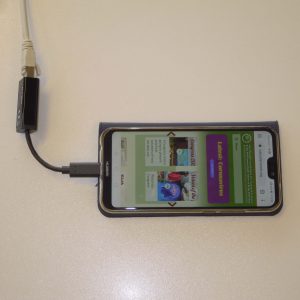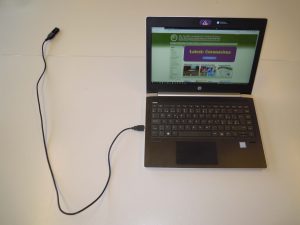Are you among the many thousands of people who all of a sudden have to work or learn from home? Or is it rather a “may” for you?
As we have already pointed out earlier, the best prophylaxis against illness is a strong immune system. However, high-frequency radiation from smartphones, Wi-Fi, Bluetooth headset etc. weakens the immune system and suppresses vitamin D3 synthesis, as studies clearly show. [A comprehensive study collection on the effect of high-frequency radiation is provided by Martin L. Pall in: “5G as a Serious Global Challenge”] Yet it is not all that complicated to set up your own home office with as little radiation as possible. We will show you how you can do this with just a few simple measures!
- In all probability, you depend on the Internet and telephone. But where does the router stand? Maybe in the living room on the ground floor? And how do you manage to bring the Internet into your office or the children’s room on the first floor?
It would be ideal if the electrician had already wired the rooms with an Internet connection and Ethernet sockets. If this is not (yet) the case, the following possibilities are worth considering: There are Ethernet cables of up to 20 metres in length which, although, when stretched across half the apartment, are not necessarily nice to look at, but they certainly serve their purpose. The third best option is PowerLine. Here, the Internet signal is fed into a normal socket using an adapter and then decoupled again in another room using another adapter. If nothing works at all, only Wi-Fi helps, but it should be used as sparingly as possible. - With a so-called “switch” (e.g. 8-way switch Netgear GS108 GE) almost any number of devices can be connected to each other and to the router and hence to the Internet.
- For telephone calls, the smartphone and the cordless telephone (DECT) should be avoided. The good, old telephone with cable is the first choice because it does not emit high-frequency radiation. (Cable telephones do indeed still exist! For example Switel Corded TF 535) It is also possible to make phone calls via the computer. For this you need a loudspeaker (already installed in the laptop) or headphones (please use a cable, not a wireless connection like Bluetooth), a microphone (already installed in the laptop) and a conference software like, for example, Skype. You can safely set the smartphone to flight mode or switch it off completely.
- If you still need to be able to be reached on your mobile phone: Switch off all other wireless services on the phone (mobile data, Wi-Fi, Bluetooth etc.).
- You may still not want to dispose of your cordless phone (DECT) straight away. Check whether the phone has a function such as “Radiation-free” or “Ecomodus Plus”. If this function is activated, the radio telephone at least only radiates when you make a phone call. If this function is not available or is deactivated, the DECT telephone radiates continuously—whether you are making a phone call or not.
- Computers, laptops, printers and other peripheral devices should always be connected via Ethernet cables. In most cases, the Wi-Fi can be avoided in this way. However, do not forget to switch off the Wi-Fi function on the router and computer (flight mode). In addition to Wi-Fi, printers often have other wireless functions with different names (e.g. WiFi-Direct), which must be deactivated individually. Make sure really all wireless services are switched off on the printer!
 Tablets and smartphones usually do not have an Ethernet socket to connect these devices to the Internet via cable. Instead, they do have a USB port, and with a standard commercially available USB-to-Ethernet adapter (e.g. Belkin USB C to Gigabit Ethernet Adapter), you can surf the Internet with your tablet or smartphone using a wired connection and turn off the wireless feature. Make sure that the USB port on your device matches that of the adapter.
Tablets and smartphones usually do not have an Ethernet socket to connect these devices to the Internet via cable. Instead, they do have a USB port, and with a standard commercially available USB-to-Ethernet adapter (e.g. Belkin USB C to Gigabit Ethernet Adapter), you can surf the Internet with your tablet or smartphone using a wired connection and turn off the wireless feature. Make sure that the USB port on your device matches that of the adapter.
- If you can’t do without Wi-Fi, switch it on during Internet use only—and then switch it off again immediately afterwards. Often the transmission power can be adjusted on the Wi-Fi router. It goes without saying that the transmission power should be set to the necessary minimum to keep radiation exposure as low as possible.
- The Wi-Fi transmitters built into laptops are positioned very close to the user, which leads to high radiation exposure. However, it is possible to connect an external Wi-Fi transmitter (e.g. D-Link DWA-131 USB Wi-Fi adapter) to a USB port using a USB extension cable, and switch off the internal transmitter. This allows you to place the transmitter further away and reduce radiation exposure.

- Of course, additional sources of radiation such as wireless computer mice, keyboards, headphones, speakers and printers should be avoided. Here too, use wired devices whenever possible.
- Electronic devices such as TV, smartphone etc. do not belong in the bedroom. And if you keep them there, they should be switched off completely at night. Only then can the body recover from the stresses and strains of the day and regenerate properly. Enabling you to master the tasks of the new day full of energy and verve!
- Simple and relatively inexpensive high-frequency measuring devices are sold in shops (approx. 200 Euro). You can use them to check whether there isn’t an undetected transmitter somewhere in your office or room that is transmitting day in, day out (e.g. Acousticom 2).
Working at home offers you and your children the great opportunity to escape the often very strong radiation exposure in the office or classroom and to give the immune system a break. Why don’t you also talk to your employer or your child´s teacher about how to reduce radiation exposure in the office or classroom? They will certainly be grateful for this valuable information!
You can order the adapters, cables etc. mentioned in the article from internet shops.








